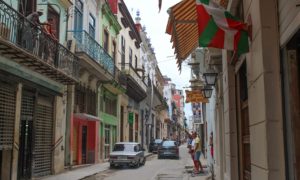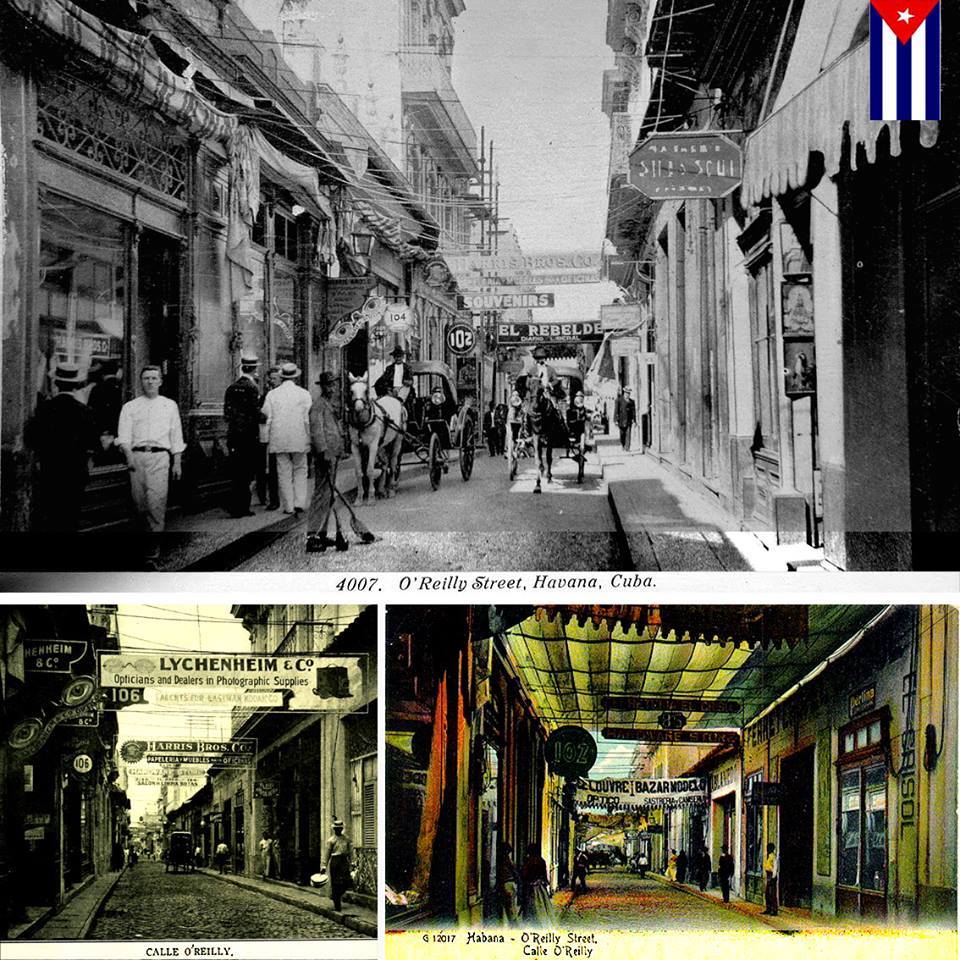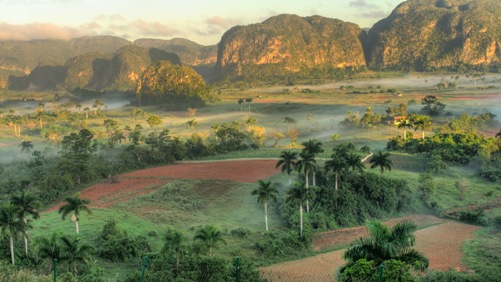O’Reilly is the street of Old Havana that is born in front of the bay next to the Castillo de la Real Fuerza. If we walk past the facade of the Palace of the Second Cape, along the side of the Palace of the Captains General, and continuing the journey we cross the streets San Ignacio, Cuba, Aguiar, Havana, Compostela, Aguacate, Villegas and Bernaza, always escorted for many houses and colonial facilities, to finally conclude in the Plazoleta de Albear, just in front of the Apple of Gómez. How much history in such a short trajectory!
Its present name takes in 1763, of the last name of the corporal, Alexander O’Reilly, for being this the way that used so great personage for its entrance to the Palace, once it was designated its position, recovered Cuba by Spain, after the British occupation.
Until 1863, O’Reilly will be the main intramural exit through the so-called “Gate of Monserrate” of the wall. By the end of this century it had already become one of the main commercial hubs of the city, as can be seen reviewing the directories and guides, commercial and / or social of Havana.
Its importance and fame already consists of the beginning of the century. In 1820 the first attempts were made to install in Havana “the best lighting that apparently was known in the main cities of the world”. The City Council of Havana would hire Mr. Lemaire, for the placement of large lampposts with platinum reflectors, installing the first in the General Captaincy and in the corners of Bishop and Mercaderes, while the press was debating the selection of selected streets for such a service and speculated on the consequences of their decisions.
“… To our understanding these events would be better placed in any extramural neighborhood of Havana but not in the busiest or in a street that could be said, it was like today that of the Bishop or O’Reilly …”
Although the streets of San Rafael, Galiano and Neptuno, both O’Reilly and Obispo streets, remained the supreme commercial streets of the old city, for the forties and fifties of the twentieth century. Important magazines of the time like “El Fígaro”, “Social” or “Libros de Cuba” of 1917 and 1925, continued to consider it the most important.
In the “Social Review” of September 1924, it is stated that in this street were only businesses that enjoyed fame and reputation and many references are found that leave no doubt about it, but long before there were many businesses which enjoyed a reputation:
The first references I encounter are prior to 1869, when the “Restaurant Paris” is already mentioned. O’Reilly 166 (before 14) “… One of the best known in Havana. For refined tastes … “(The Blue Book, 1917). There are also references to “S.Spencer”. O’Reilly, no. 12; “The encyclopedia”. O’Reilly no. 91; “The Farm” O’Reilly, no. 13 and “La Dominica” O’Reilly.
To get an idea of the number of businesses established in this street, as a summary I comment only a few:
“The Galleries,” O’Reilly and Compostela, a clothing store whose specialty was white linen, which was exceptional “… as hitherto had not been the occasion to see in Havana …” (El Fígaro, 1914).
“Atelier Otero”. O’Reilly 459, before 63. (Photographic and painting studio) “… Photographs of every size and class. Color photographs and portraits of platinum, oil, crayons and pastels. And to please the wider clientele, he accepted orders to take photographs at home. They spoke Spanish, English and French … “(The Blue Book, 1917).
“P. Ruiz and Hno “. O’Reilly and Habana. (Engravings and papermakers) “… True works of art on baptismal, visiting cards, wedding invitations, menus, stationery, etc.” (Social, 1919).
“Casa de Álvarez”. O’Reilly 503, before 73. (Musical Effects) The best of music. Victrolas and Columbias, among other magnificent equipment of the accredited brand Rica, manufactured in New York. (Social, 1921).
“The century”. (Furniture) “… Nothing more regal or exquisite in the matter of furniture …” (Libro de Cuba, 1925).
“The Carmona House”. O’Reilly, old 47. (Leather and footwear). “… Thousands of pairs of the famous Rompe-Roca footwear and thousands of pairs of the most popular poloina of Cuba, the brand Toro, distributed throughout the island and brands of guarantee …” (Libro de Cuba, 1925).
“Casa Giralt”. O’Reilly 457, old 61. (Musical effects) “… Fame to sell only instruments of the best kind …” (Libro de Cuba, 1925)
Etc etc.…
HISTORIAS DE LA HABANA VIEJA: LA CALLE O’REILLY. (Fotos).
O’Reilly es la calle de la Habana Vieja que nace frente a la bahía junto al Castillo de la Real Fuerza. Si la caminamos pasamos frente a la fachada del Palacio del Segundo Cabo, por el costado del Palacio de los Capitanes Generales, y continuando el trayecto cruzaremos las calles San Ignacio, Cuba, Aguiar, Habana, Compostela, Aguacate, Villegas y Bernaza, siempre escoltados por muchas viviendas e instalaciones coloniales, para finalmente concluir en la Plazoleta de Albear, justo frente a la Manzana de Gómez. ¡Cuánta historia en tan corta trayectoria!
Su nombre actual lo toma en 1763, del apellido del segundo cabo, Alejandro O’Reilly, por ser ésta la vía que utilizara tan insigne personaje para su entrada al Palacio, una vez que le fuera designado su cargo, recuperada Cuba por España, tras la ocupación británica.
Hasta 1863, O´Reilly será la principal salida de intramuros a través de la tan mencionada “Puerta de Monserrate” de la muralla. Para finales de este siglo ya se había convertido en uno de los principales ejes comerciales de la ciudad, según se puede apreciar revisando los directorios y guías, comerciales y/o sociales de La Habana.
Su importancia y fama ya consta de comienzos del siglo. En 1820 se llevaron a cabo los primeros intentos de instalación en La Habana “del mejor alumbrado que al parecer se conocía en las principales ciudades del mundo”. El Ayuntamiento de La Habana contrataría a Mr. Lemaire, para la colocación de grandes farolas con reflectores de platina, instalándose los primeros en la Capitanía General y en las esquinas de Obispo y Mercaderes, mientras, la prensa se debatía enjuiciando la selección de calles seleccionada para tal servicio y especulaba sobre las consecuencias de sus decisiones.
“…A nuestro entender estos sucesos estarían mejor colocados en cualquier barrio extramural de la Habana pero no en el más concurrido ni tampoco en una calle que pudiera decirse, era como hoy la del Obispo u O’Reilly…”
Aunque para los años cuarenta y cincuenta del siglo XX, la supremacía la tenían las calles San Rafael, Galiano y Neptuno, tanto la calle O’Reilly como Obispo, continuaron siendo las calles comerciales, por excelencia, de la antigua ciudad. Revistas importantes de la época como “El Fígaro”, “Social” o los “Libros de Cuba” de 1917 y 1925, continuaban considerándola la de mayor importancia.
En la “Revista Social”, de septiembre de 1924, se afirma que en esta calle sólo estaban negocios que gozaban de fama y reputación y son muchas las referencias encontradas que no dejan duda de ello, pero desde mucho antes ya existía en ella muchos negocios que gozaban de reputación:
Los primeras referencias que encuentro son anteriores a 1869, cuando ya se comenta del “Restaurant París”. O’Reilly 166 (antes 14) “…Uno de los más conocidos de La Habana. Para gustos refinados…” (El Libro Azul, 1917). También aparencen referencias a “S.Spencer” . O’Reilly, núm. 12; “La Enciclopedia”. O’Reilly núm. 91; “La Granja” O’Reilly, núm. 13 y “La Dominica” O’Reilly.
Para tener una idea de la cantidad de negocios establecidos en esta calle, a modo de resumen les comento solo algunos:
“Las Galerías”, O’Reilly y Compostela, Tienda de confecciones cuya especialidad era la ropa blanca, que era excepcional “…como hasta ese momento no se había tenido ocasión de ver en La Habana…” (El Fígaro, 1914).
“Atelier Otero”. O’Reilly 459, antes 63. (Estudio fotográfico y de pintura) “…Fotografías de todo tamaño y clase. Fotografías en colores y retratos al platino, óleo, creyones y pasteles. Y para complacer a la más amplia clientela, aceptaba órdenes para tomar fotografías a domicilio. Se hablaba español, inglés y francés…” (El Libro Azul, 1917).
“P. Ruiz y Hno”. O’Reilly y Habana. (Grabadores y papeleros) “…Verdaderas obras de arte en tarjetas de bautizo, de visita, invitaciones de bodas, menús, papel de carta, entre otros…” (Social, 1919).
“Casa de Álvarez”. O´Reilly 503, antes 73. (Efectos musicales) Lo mejor de música. Victrolas y Columbias, entre otros magníficos aparatos de la acreditada marca Rica, fabricados en Nueva York. (Social, 1921).
“El Siglo”. (Mueblería) “…Nada más regio ni exquisito en materia de muebles…” (Libro de Cuba, 1925).
“La Casa Carmona”. O’Reilly, antiguo 47. (Cuero y calzado). “…Miles de pares del famoso calzado Rompe-Roca y miles de pares de la más popular polaina de Cuba, la de marca Toro, distribuidos por toda la isla y marcas de garantía…” (Libro de Cuba, 1925).
“Casa Giralt”. O’Reilly 457, antiguo 61. (Efectos musicales) “…Fama de vender solo instrumentos de la mejor clase…” (Libro de Cuba, 1925)
Etc, etc.…
Agencies/MemoriasCubanas/Derubín Jácome/Excerpts/Internet Photos/ Arnoldo Varona/ TheCubanHistory.com
THE CUBAN HISTORY, HOLLYWOOD.









